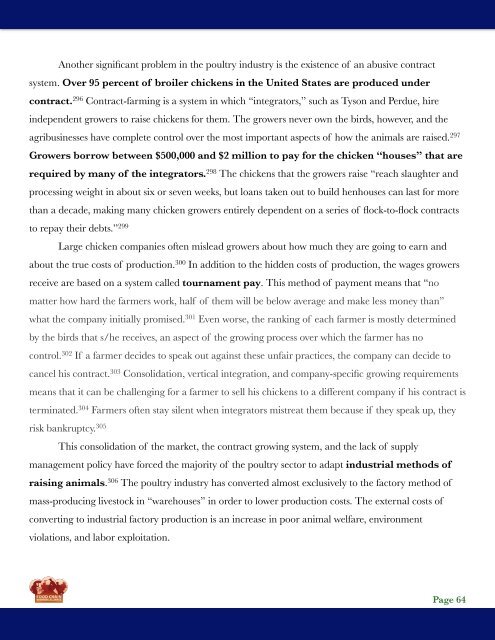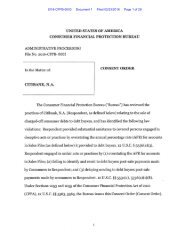Walmart-at-the-Crossroads-FINAL-06.04.15
Walmart-at-the-Crossroads-FINAL-06.04.15
Walmart-at-the-Crossroads-FINAL-06.04.15
You also want an ePaper? Increase the reach of your titles
YUMPU automatically turns print PDFs into web optimized ePapers that Google loves.
Ano<strong>the</strong>r significant problem in <strong>the</strong> poultry industry is <strong>the</strong> existence of an abusive contract<br />
system. Over 95 percent of broiler chickens in <strong>the</strong> United St<strong>at</strong>es are produced under<br />
contract.<br />
296<br />
Contract-farming is a system in which “integr<strong>at</strong>ors,” such as Tyson and Perdue, hire<br />
independent growers to raise chickens for <strong>the</strong>m. The growers never own <strong>the</strong> birds, however, and <strong>the</strong><br />
agribusinesses have complete control over <strong>the</strong> most important aspects of how <strong>the</strong> animals are raised.<br />
297<br />
Growers borrow between $500,000 and $2 million to pay for <strong>the</strong> chicken “houses” th<strong>at</strong> are<br />
required by many of <strong>the</strong> integr<strong>at</strong>ors.<br />
298<br />
The chickens th<strong>at</strong> <strong>the</strong> growers raise “reach slaughter and<br />
processing weight in about six or seven weeks, but loans taken out to build henhouses can last for more<br />
than a decade, making many chicken growers entirely dependent on a series of flock-to-flock contracts<br />
to repay <strong>the</strong>ir debts.”<br />
299<br />
Large chicken companies often mislead growers about how much <strong>the</strong>y are going to earn and<br />
about <strong>the</strong> true costs of production.<br />
300<br />
In addition to <strong>the</strong> hidden costs of production, <strong>the</strong> wages growers<br />
receive are based on a system called tournament pay. This method of payment means th<strong>at</strong> “no<br />
m<strong>at</strong>ter how hard <strong>the</strong> farmers work, half of <strong>the</strong>m will be below average and make less money than”<br />
wh<strong>at</strong> <strong>the</strong> company initially promised.<br />
301<br />
Even worse, <strong>the</strong> ranking of each farmer is mostly determined<br />
by <strong>the</strong> birds th<strong>at</strong> s/he receives, an aspect of <strong>the</strong> growing process over which <strong>the</strong> farmer has no<br />
control.<br />
302<br />
If a farmer decides to speak out against <strong>the</strong>se unfair practices, <strong>the</strong> company can decide to<br />
cancel his contract.<br />
303<br />
Consolid<strong>at</strong>ion, vertical integr<strong>at</strong>ion, and company-specific growing requirements<br />
means th<strong>at</strong> it can be challenging for a farmer to sell his chickens to a different company if his contract is<br />
termin<strong>at</strong>ed.<br />
304<br />
Farmers often stay silent when integr<strong>at</strong>ors mistre<strong>at</strong> <strong>the</strong>m because if <strong>the</strong>y speak up, <strong>the</strong>y<br />
risk bankruptcy.<br />
305<br />
This consolid<strong>at</strong>ion of <strong>the</strong> market, <strong>the</strong> contract growing system, and <strong>the</strong> lack of supply<br />
management policy have forced <strong>the</strong> majority of <strong>the</strong> poultry sector to adapt industrial methods of<br />
raising animals.<br />
306<br />
The poultry industry has converted almost exclusively to <strong>the</strong> factory method of<br />
mass-producing livestock in “warehouses” in order to lower production costs. The external costs of<br />
converting to industrial factory production is an increase in poor animal welfare, environment<br />
viol<strong>at</strong>ions, and labor exploit<strong>at</strong>ion.<br />
Page !64



